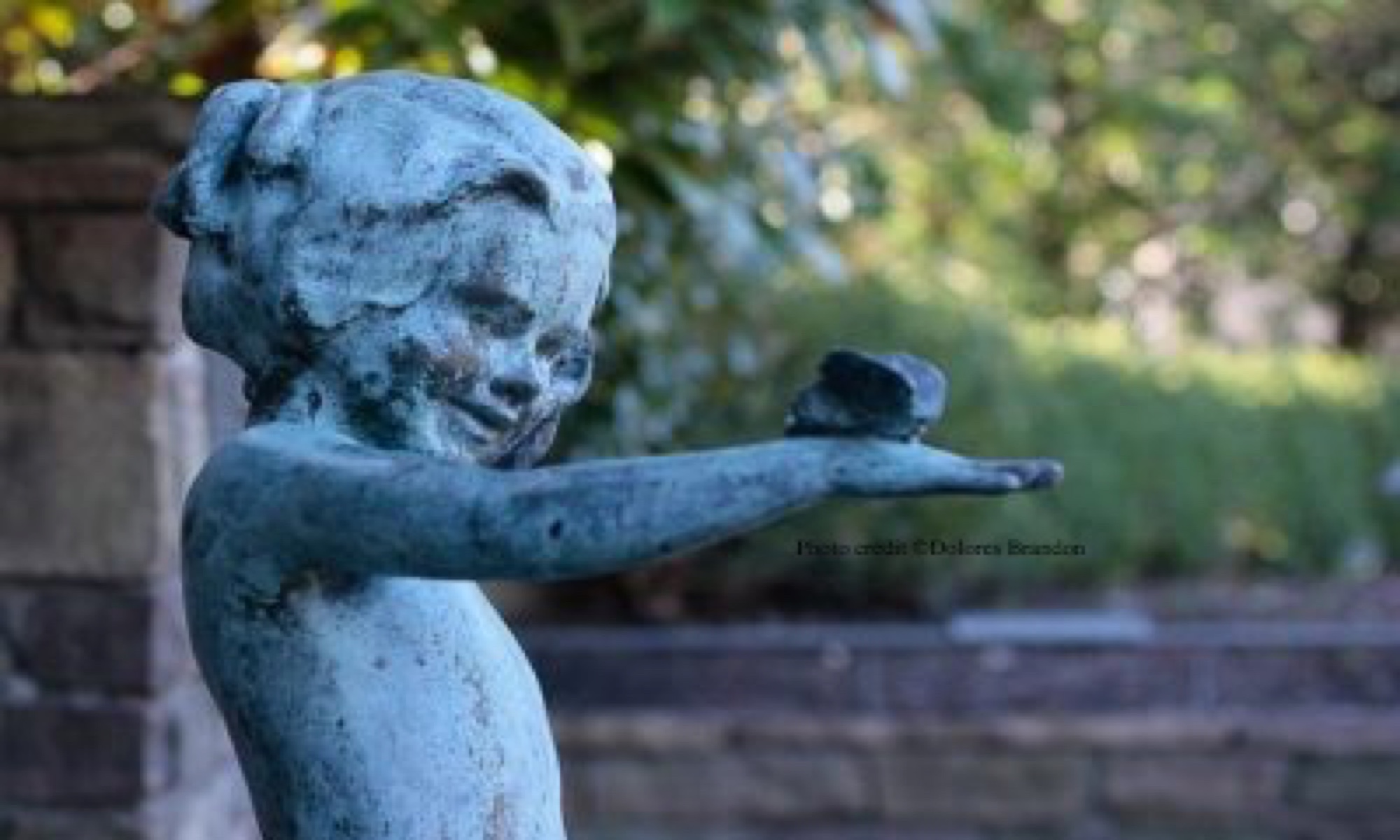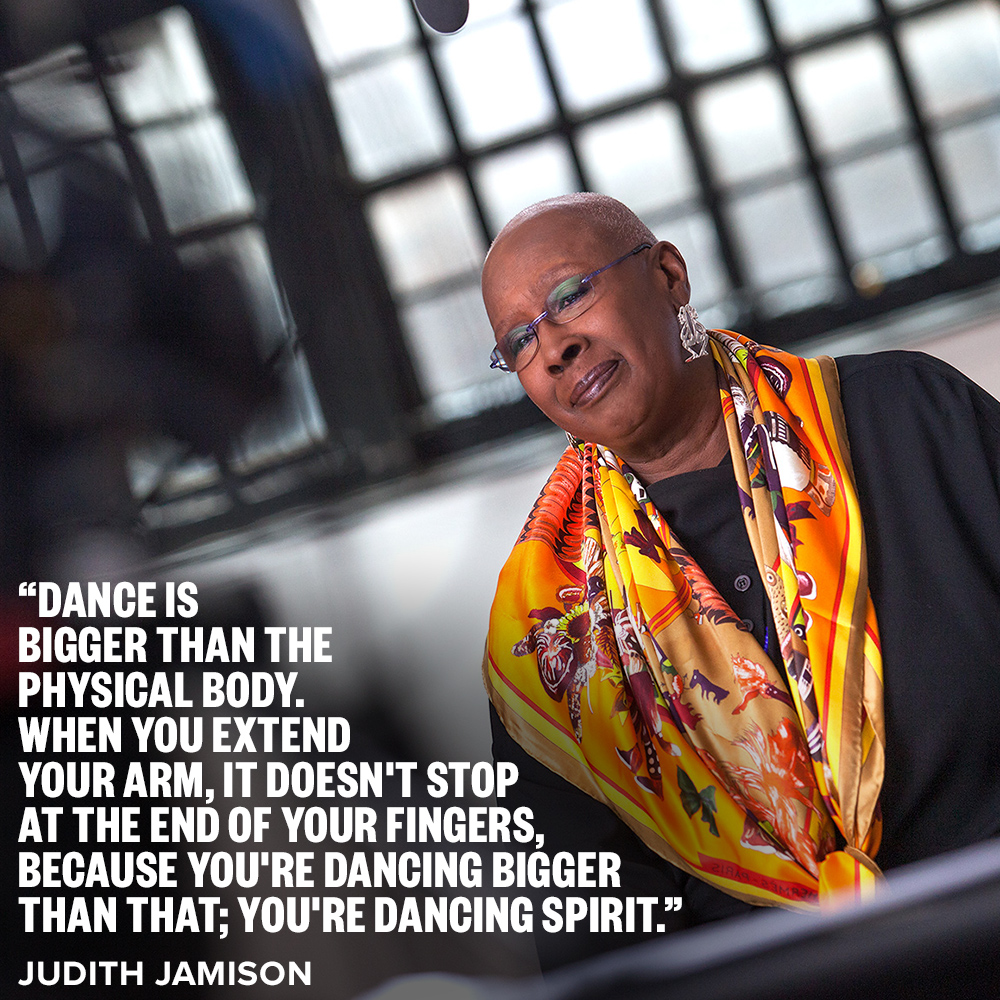The attached two radio features were produced in 1993 for CROSSROADS a radio magazine distributed nationally via NPR and Pacifica stations. They mark the publication of Ms. Jamison’s autobiography Dancing Spirit and the 35th Anniversary Celebration season of the Alvin Ailey American Dance Theater.
Disarmingly humble, Judith Jamison credits spirtitual forces and “an arms-length” of mentors and guardians who helped propel her career. Among others, she names – Marion Cuyjet – her first dance teacher in Phhiladelphia, and Agnes de Mille.
Jamison is particularly keen to acknowledge the influence and impact of the often under-credited African American dance legend ,Katherine Dunham, who she calls “one of the mothers of modern dance”.
She speaks also of her role as heir and guardian for the Alvin Ailey American Dance Theater legacy. Accepting the position of Artistic Director and successor to Alvin Ailey upon his death in 1989, Jamison defines her leadership philosophy and aesthetic goals as the company prepares to celebrate the Ailey company’s 35th Anniversary season.
In her own words
BRANDON: You dedicate DANCING SPIRIT to family – not only your personal family but also the family of dancers. What is it about “family” that so inspires you?
JAMISON: Continuity. Families provide continuity to one’s life, you know there’s a lineage; you know somebody came before you, has prepared a way for you.
As a member of the Alvin Ailey American Dance Theater you know, you kind of get into this other world: every night we dancers are thrown bouquets, we’re given the ultimate embrace by audiences; we’re told how wonderful we are, we’re applauded, people scream and yell. You can begin to think the world revolves around YOU. Family [reminds you] you have two legs, and you have to go do your laundry like everybody else. You are a human being.
Alvin Ailey’s choreography lends itself to that kind of humanity – remembering family, and remembering people, and remembering the humanity of it all.
Talking about dancers, and former dancers is like talking about ancestors; it’s like talking about that big family that’s been going since the beginning of time.
I am especially thankful for the dancers who appreciate the contributions of African American dancers [both past and present] who bring their gifts to this wonderful art we call dance – [choreographers and dancers like] Katherine Dunham and Dr. Pearl Primus. They’ve given us our place in the sun today. Dunham was a major influence on Alvin.
BRANDON: Please expand on the importance of the African American lineage in American dance.
JAMISON: Everyone talks about Martha Graham as being one of the mothers of modern dance. No one talks about Dunham, and the influence she had on African American dancers, that she was the first spectacle that Alvin saw when he was young. [In Dunham] he saw people of color on stage celebrating life very colorfully. Her influence sometimes is negated. Historically, it would have to be Dunham influencing everyone from Talley Beatty, to Donald McKayle, George W. Faison, Ulysses Dove. I mean we’re all under that umbrella of mother Dunham and I think that Alvin’s original dream for this company was he wanted African American themes with modern dance idioms; he wanted both things.
He wanted modern dance to be celebrated. That’s why the fabric of the Ailey company is that you have to have four techniques under your belt before you walk in the door. You have to have Horton technique because that’s what REVELATIONS is based on, [as are] BLUES SUITE and CRY etc. You’ve got to have some Dunham, you’ve gotta have classical ballet, and you’ve gotta have Graham.
His goal was to build a company that would not get categorized as African American, even though it’s predominantly African Americans. He wanted a venue for African American dance, to celebrate the experience, the Black experience.
BRANDON: Martha Graham is quoted saying: “America’s great gift to the arts is rhythm: rich, full, unabashed, virile. Our two forms of indigenous dance, the Negro and the Indian are as dramatically contrasted rhythmically as the land in which they root.” African American artists in particular are often stereotyped, even marginalized on this topic of rhythm.
JAMISON:
Well, just the other day, I heard a composer say something about rhythm; he was describing how he listened to classical music for melody, and he listened to R&B, and rap for rhythm, and he had this separation of – okay) black people do rhythm, and white people do melody. I sat there and I thought, what is he talking about? He,[aparently] never heard my grandmother sing, never heard Sweet Honey in the Rock.
I think of Stravinsky: now if you could sing along with anything he wrote, that would be a miracle – right? But what rhythm, what syncopation. And, Duke Ellington, what melodies, what harmonies along with the jammin’ band! I’m sure part of what Alvin was taken by was the coloration in the sound that Duke Ellington put together – those harmonies. You know when you hear an Ellington song – the Sacred Songs, distinctively Ellington. You get both – melody and rhythm and they’re in a balance.
And, drums. I love drums. In the book, I talk about heartbeat, I talk about passion, and drums – one of which I was given to me by Doudou Ndiaye Rose, the master drummer of Senegal. That drum had to be tuned before he handed it to me, for the melody of it, you know; not just for the rhythm of it.
I hate to say categorically, that one does this or another does that. We all have things to contribute.
BRANDON: It struck me, reading DANCING SPIRIT, that yours is not a rags to riches story; it’s a riches to riches story. From the very beginning, you were immersed in a rich cultural milieu.
JAMISON: Absolutely. Growing up in Philadelphia helped a lot: [there was] The Philadelphia Art Museum, The Rodin Museum: my parents made sure that I saw the great works of art, the exhibits that would come through. And, theater: The Academy of Music where I saw the Ballet Russe for the first time when I was ten years old. {We sat] all the way up at the top of the Academy of Music so that the tutus looked like little discs around these bodies because of the perspective looking down from that high in the theater.
There was Marion Cuyjet my first teacher: she made sure that [her students] got to study with as many people as possible: I studied with Anthony Tudor when I was ten. I studied with him for about three years and a half years.
And, Church, oh my goodness, Mother Bethel AME Church. Now that to me is a very important part of what has shaped me to become the woman I am today – the Church: not in a standard kind of religious way, but in a spiritual way. The pageantry of the Church, the way it smelled, the way it looked on Communion Sundays with the altar all in white, and the lilies in the pulpit, and the sanctuary looking as if it were actually raised above the ground. It was so light and airy. The stain glass windows, the many choirs. And the colorful ministers, the messages they were giving us got us through the week.
BRANDON: As Artistic Director, successor to Alvin Ailey, what are your goals with the company.
JAMISON: Well, gosh we’re really on a roll [with this 35th Anniversary season]; we have a wonderful opening night [planned] with a work called HYMN. Anna Deavere Smith and I collaborated on this; I wanted it to be a gift from myself to Alvin, and from the dancers to Alvin, so I asked Anna to interview all of the dancers, my Associate Director, Masazumi Chaya and myself. We’re all in it; there’s something like 33 people on the stage. Anna becomes them on stage while they dance to their own words. It’s riveting, to say the least. It’s the first time the Company’s done anything with everyone in the Company on stage. And I’m very excited about that collaboration.
And, Jerry Robbins, Jerome Robbins: Alvin always wanted to include a piece by Jerry but never got one. Last year Robbins sent me a letter saying it would be nice if the Company would do one of his works. I said WONDERFUL! The work that he gave us N.Y.EXPORT: OPUS JAZZ. it’s 35 years old and the Ailey company’s 35 years old – so, it’s perfect
[Making things like that happen], that’s part of my conduit position; [I’m the] catalyst, the one who follows through and does what Alvin was thinking, ten years ago, 20 years ago.
Garth Fagan. Ten years ago Alvin was reaching out to Fagan: timing and scheduling conflicts got in the way. Finally [it’s happening]. Garth’s given us JUKEBOX FOR ALVIN, which is a wonderful, wonderful tribute to Alvin.
This season we’ll be doing a revival of THE MOOCH; it’s one of Alvin’s favorite works, and it’s also one of mine; it’s an extravagant piece, a theatrical piece.
I’m showing the diversity of the company like it’s never been seen before. Because I stand on Alvin’s shoulders, that means I see a broader horizon. He left me a road map, and you can’t fix what isn’t broken.
BRANDON: Broader horizons?
JAMISON: REVELATIONS will be done live for this year’s annual gala benefit opening. It hasn’t been done with LIVE music in a long time. Jesse Norman will sing Fix me Jesus, Al Jareau will sing Sinner Man, and Dionne Warwick sings Wading in the Water; Brother John Sellars, and Denzel Washington are Co Chairs, Dr. Maya Angelou is reading a poem. I look forward to doing more live performances in the future.
BRANDON: And, aesthetically – what’s your goal?
JAMISON: I see continuing the legacy. I see adding works, the Garth work; I see myself maybe getting a chance to choreograph a little bit more, I see discovering new choreographers, new music. That’s already in built, that’s the heritage of the Alvin Ailey Dance Company. It is a repertory company.
BRANDON: The title – DANCING SPIRIT. Please tell us why you chose that title for your autobiography.
JAMISON: DANCING SPIRIT came to me after about twelve titles because I consider dancing to be something very spiritual: I believe the first thing we do [as infants] is move; you’ve got to do the gesture of opening your mouth before you can release sound.
When I was learning dance [I was taught] not just to do steps, but to dance from some other place, some place very deep inside, that’s connected to your heart, and your spirit. I think Alvin knew choreographically exactly how to do that. And, I consider Alvin Ailey to have been my spiritual walker, someone that will always be there with me, even if they’re not there physically.
There are too many situations that I’ve been in that are miraculous, things I feel I didn’t have anything to do with at all, that they were there and I was guided into those situations. Like the many mentors that I speak about in the book. I mean it’s an arms-length of mentors, people I have put myself around. Constantly since the day I was born I’ve been surrounded by extraordinary guides, and [it’s the same] to this day.
I’ve always felt my life was predestined. I really feel guarded, and protected, and I feel guided. I’ve always been told to prepare myself, just prepare myself to be the best that I could be, and everything else will take care of itself, and thus far it certainly has.

